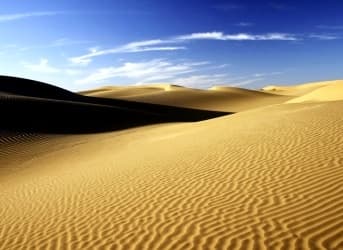For the past two millennia, “Saharina” has been a byword for desertification.
Now, thanks to an innovative project, The “Sahara Forest Project,” the world’s biggest largest desertification region may yet bloom again.
Funded by Qatar, the “Sahara Forest Project” seeks to make the desert bloom again by the oil-rich country’s National Food Security Program turning the country into a nation self-sustainable by 70 percent on food production by 2023.
And, the project produces energy as well.
Launched in 2009 by a group of Qatari entrepreneurs, the Sahara Forest Project is an agricultural initiative that utilizes sunlight, sand and carbon dioxide (CO2), to produce a self-sufficient food production system with water and energy. The Sahara Forest Project is intended to create opportunities for small-scale, family farmers to grow food and produce energy and drinking water in arid and inhospitable conditions.
The Sahara Forest Project website reports, “The Sahara Forest Project is a new environmental solution to create re-vegetation and green jobs through profitable production of food, water, clean electricity and biomass in desert areas.”
How?
“The Sahara Forest Project is designed to utilize what we have enough of to produce what we need more of, using deserts, saltwater and CO2 to produce food, water and clean energy. This is done by combining already existing and proven environmental technologies, including saltwater-cooled greenhouses, concentrated solar power (CSP) and technologies for desert revegetation around a saltwater infrastructure. The synergies arising from integrating the technologies improve the performance and economics of the system compared to those of the individual components.”
The project’s pilot facility is in Qatar, which was chosen for its location and access to funding. Water comes from a seawater pipeline pumped from the Persian Gulf, utilizing saltwater-cooled greenhouses, solar power and other technologies including evaporative hedges. The saltwater-cooled greenhouses use seawater that is evaporated by wind instead of by fans, cooling and humidifying the greenhouses, while solar energy produces electricity and heat. The website continues, “The production of key resources, such as clean water, clean energy and a sustainable production of food represents some of our time’s greatest challenges.”
Three key components are involved - saltwater-cooled greenhouses, solar power and evaporative hedges.
The seawater cools and humidifies the greenhouses, while the greenhouse is enriched with carbon dioxide from the fertilizer factory next door. Solar energy produces electricity and heat while indirectly producing electricity via a steam turbine, and the evaporative hedges enable vegetative growth by sheltering plants that would normally not be able to grow in open, arid environments through a cooler, more humid environment.
The Qatari facility came online in December 2012, while a similar site is set for development in Jordan.
While the initial site is modest, a one-hectare site outside Doha, Qatar, the Sahara Forest Project Pilot Plant’s operating premises have been proven. According to the project’s website, its “Result report for pilot facility” noted, “The yields obtained in the pilot stage are competitive with that of leading European greenhouse operations… The greenhouse achieved up to 15 degrees cooling in summer… The water usage is half of comparable greenhouses in the region… the seawater-cooled greenhouse allows for year-round production of high quality crops, even through the hot Qatari summer…”.
The Sahara Forest Project has also signed joint ventures with Yara ASA, the world’s largest supplier of fertilizer and Qatari company Qafco, the world’s largest single site producer of urea and ammonia for future collaboration.
Electricity and fresh water from seawater, carbon dioxide and sunlight – assuming that the project can be ramped up to industrial production, Qatar may yet help the world’s largest desert bloom yet again.
By. John C.K. Daly of Oilprice.com


















